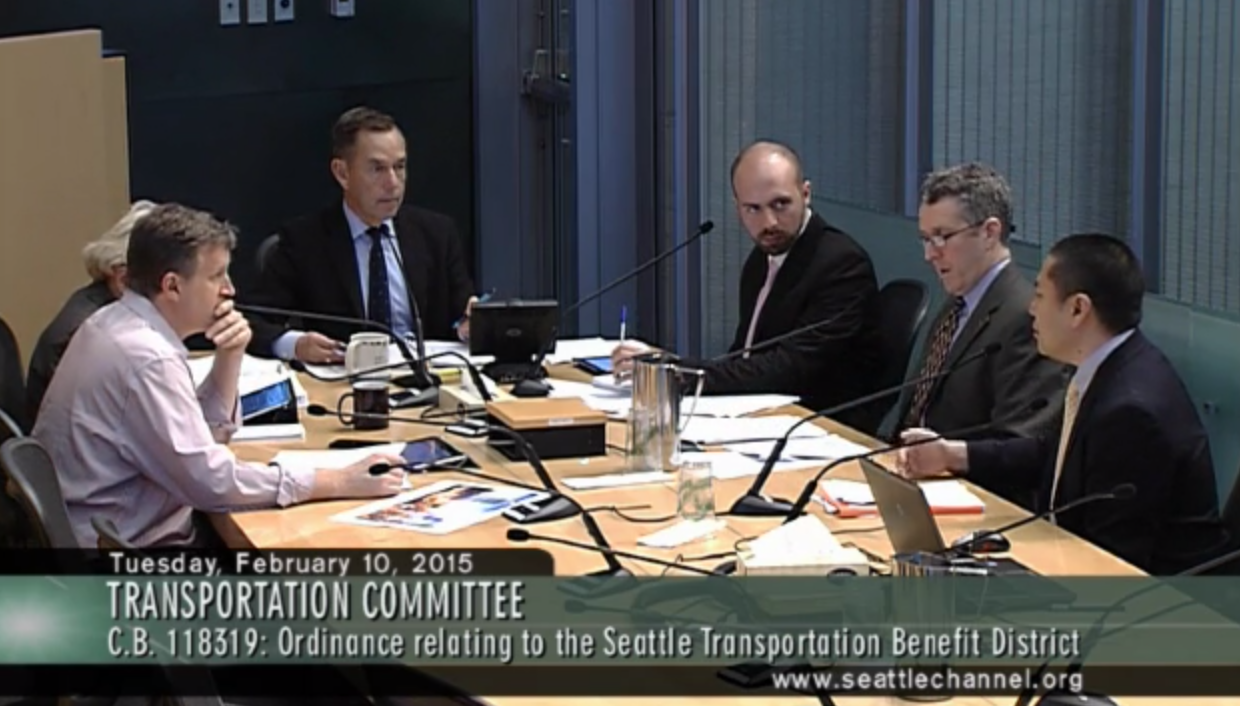
Seattle is poised to add more than 200,000 service hours to city bus routes in two rounds of service change, June and September, thanks to the recent passing of Proposition 1. But before that can happen, the City of Seattle–wearing the hat of the Seattle Transportation Benefit District–and King County must hammer out the final details. Yesterday, Seattle City Councilmembers Tom Rasmussen, Jean Godden, and Mike O’Brien met to discuss the terms of the plan further, and ultimately voting to send the matter before the full Council. During their biweekly Transportation Committee, the councilmembers were briefed on the details of the new service agreement with King County Metro Transit and the creation of a transit advisory board.
Highlights of the Service Agreement
SDOT staff outlined three areas in which service hours would be allocated: routes with peak overcrowding, routes suffering from severe unreliability, and expansion of the off-peak transit network. Metro Transit’s guidelines call for 12,000 more service hours on overcrowded peak routes, but Seattle would go well beyond this by providing up to 51,000 service hours. Unreliable routes would get a further 21,000 service hours. And the off-peak network would see an increase of 141,000 service hours for the mid-day and evening times. Frequencies would increase during those times with service being extended later into the night and on weekends.
A big issue in the service agreement is the prohibition on supplanting service. The term probably seems foreign, but illustrate the concept, consider a single, overcrowded peak route. Under Metro’s Service Guidelines, such a route would be a priority candidate for service investment. But if the City were to kick in funding, Metro’s obligation for further investment could go away. Why is this? Well, the peak-oriented route could see an average reduction in crowding meaning that the route is no longer a high priority for additional investment by Metro. In other words, the City may have solved a problem routes, but would be stuck paying for it when while Metro is free to spend their countywide funding elsewhere. This is exactly why the City has negotiated terms that would preclude Metro from supplanting service.
So, as Metro’s countywide funding goes up and the agency can afford to increase service, Seattle could back out funding under the agreement and focus it on “lower priority” routes. SDOT staff noted that they will develop metrics and ways to directly identify where every service hour dollar goes within the Seattle network. By doing so, the agency can ensure that supplanting does not occur, and that service hours can be reallocated when the time comes.
Fleet replacement and expansion was another noteworthy issue. With Seattle purchasing so many service hours, Metro will need to procure additional buses to backfill peak-hour routes. The City will responsible for paying a portion of the cost for procuring the new buses. Metro will have to disclose the full cost of each newly procured bus and amortize it over the life of the bus. The City would then pay the additional costs on the amortized basis as opposed to the full cost of the bus upfront. Should the contract not be renewed, there would be outstanding liabilities on the procured buses. Metro will take on the liabilities for the diesel buses, but the City could be on the hook for the 14 electric trolleybuses.
And, while the City will be putting in a lot of money for service increases, there will be some kickbacks in the form of farebox revenue. Under the service agreement, the City of Seattle would recover 29% of operating costs on standard bus routes while trolleybus routes would recover as much as 41%. These farebox recovery ratios are pegged to the current countywide routes and the busier trolleybus routes that only operate in Seattle. An estimate provided by City staff puts to total farebox recovery for Seattle at around $11.2 million.
New Transit Advisory Board
Separate from the discussion of the service agreement, the councilmembers were briefed on a resolution to create a transit advisory board. Proposition 1 called for this body to oversee the service investments deriving from the measure, but the new Seattle Transit Advisory Board (STAB) would have a wider scope. The STAB would be on par with other transportation advisory boards like the Pedestrian Advisory Board and Bicycle Advisory Board by looking at all transit-related issues. The STAB will likely be a sounding for topics like fare media, bus routings, advertising on bus stops, and more. But the central focus will still be on ensuring that the service agreement investments are fair, equitable, and in the spirit of the Transit Master Plan and Metro’s Service Guidelines.
Stephen is a professional urban planner in Puget Sound with a passion for sustainable, livable, and diverse cities. He is especially interested in how policies, regulations, and programs can promote positive outcomes for communities. With stints in great cities like Bellingham and Cork, Stephen currently lives in Seattle. He primarily covers land use and transportation issues and has been with The Urbanist since 2014.



